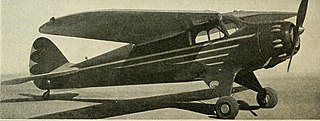The Pemberton-Billing P.B.25 was a First World War British single-seat scout aircraft built by Pemberton-Billing Limited, later Supermarine Aviation Works Limited.
The Shackleton-Murray SM.1 was a single-engined two-seat light aircraft designed in Britain and flying in 1933. It was a pusher driven parasol winged monoplane. Only one was built.
The Pobjoy Pirate was a three-seat, high-wing monoplane designed to compete with the de Havilland Leopard Moth using a low power but light Pobjoy radial engine. Flight tests showed the Pirate to be uncompetitive and its development was rapidly abandoned.

The PWS-11 was a Polish aerobatic and trainer aircraft, developed in 1928-1929 by PWS, which remained a prototype.
The Latécoère 225 was an unusual single seat canard microlight amphibian, with a swept wing, and of pusher configuration. It first flew in 1984 but was not put into production.
The Starck AS-37 is a two-seat biplane with unconventional wing and propulsion layouts. It was designed in France in the 1970s; though three were built and more than twenty sets of plans sold for home building, no AS-37s are active in 2012.

The Siemens-Schuckert DDr.I was a World War I German twin engine, push-pull configuration triplane fighter aircraft. Only one was built, crashing on its first flight.

The Short S.36 was a British two-seat tractor biplane, built by Short Brothers for Francis McClean in 1911. It was later developed into the Short S.41 and Short S.45, which were the first of a long series of similar aircraft built for the RNAS and RFC.

The Albatros L.71 was a two-seat, single pusher engined biplane built in Germany in the 1920s.
The ViS Sprint is a pusher configuration, pod-and-boom two-seat ultralight, designed and built in the Ukraine in the mid-2000s. It can serve as an agricultural spraying aircraft.

The Caudron Type A was the first successful aircraft built by René Caudron and his brother Gaston. During 1910 the Caudron brothers were briefly associated with the Société Anonyme Français d'Aviation (S.A.F.A.), and an example of the type was exhibited at the 1910 Paris Aero Salon as the S.A.F.A. Biplane.
The Bloch MB.90 was the first all-metal French light aircraft. Only two aircraft were completed, making their first flights in 1932, though there were several variants.
The Gribovsky G-25 was a Soviet tandem seat biplane basic trainer built in the late 1930s. It was hoped to minimize unit costs by using a modified automobile engine but the G-25 did not reach production.
The Landray GL.03 Pouss Pou was a small, pusher configuration tandem wing aircraft built in France in the early 1980s. Only one was completed, though it was much modified.

The Caudron C.74 was a ten-seat, four engine passenger biplane built in France in 1922. It showed promise but the sole prototype crashed fatally in a competition and no more were completed.

The Caudron Type L was a two-seat French pusher configuration amphibious biplane, flown around 1913 and intended for naval use.

The Blériot-Spad S.45 was a large, four engine French airliner which appeared at the 1921 Paris Salon. It could carry fifteen passengers or be adapted as a bomber.
The Moskalyev SAM-11 was an amphibious version of the SAM-5bis-2, with a flying boat hull, retractable landing gear and raised engine and tail to avoid spray. Only one was built.

The Ireland Neptune was a four or five place pusher configuration biplane sold in flying boat and amphibian versions. Designed in the U.S. and first flown in 1927, well over 50 were built.

The Swanson-Fahlin SF-1 was a high wing, two seat cabin aircraft with a small radial engine, designed in the United States and first flown in 1934. Only one was built.










